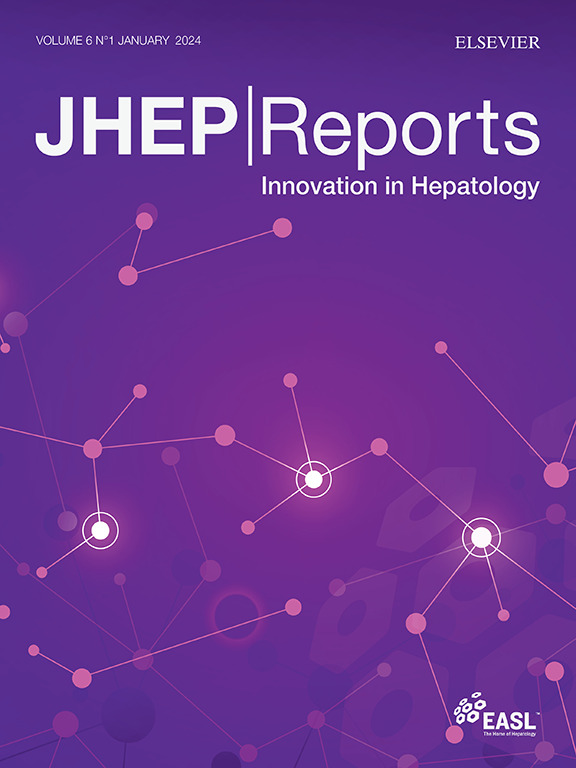Genetic variants influencing liver fat in normal-weight individuals of European ancestry
IF 9.5
1区 医学
Q1 GASTROENTEROLOGY & HEPATOLOGY
引用次数: 0
Abstract
Background & Aims
Metabolic dysfunction-associated steatotic liver disease (MASLD) occurs across a wide spectrum of body weights, yet the genetic determinants underlying hepatic steatosis in individuals with normal BMI remain underexplored. This study aimed to identify genetic variants associated with liver fat fraction in normal-weight individuals.
Methods
We performed a genome-wide association study (GWAS) using magnetic resonance imaging-proton density fat fraction (MRI-PDFF) data from 10,918 normal-weight participants (BMI <25 kg/m2) of European ancestry in the UK Biobank. Hepatic steatosis and liver fat content were assessed using both case–control (CC; 815 cases with MRI-PDFF ≥5% vs. 10,103 controls with MRI-PDFF <5%) and quantitative trait (QT; N = 10,918, with MRI-PDFF as a continuous outcome) designs. Fine mapping prioritized potential causal variants. Gene-level associations were evaluated using multi-marker analysis of genomic annotation (MAGMA), and liver-specific gene expression was imputed for transcriptome-wide association studies (TWAS).
Results
We identified 241 genome-wide significant variants in the CC-GWAS and 418 in the QT-GWAS, with most located on chromosomes 19 and 22, including known loci such as PNPLA3, TM6SF2, and SAMM50. Fine-mapping analyses prioritized three candidate causal variants in SUGP1, GATAD2A, and MAU2. MAGMA identified eight genes in CC-GWAS and 19 in QT-GWAS, including a novel association with RFXANK. TWAS supported the involvement of MBOAT7 and SAMM50, with fine mapping further implicating SAMM50 as a likely causal gene.
Conclusions
This study, one of the first to detect genome-wide associations for hepatic steatosis in normal-weight individuals, identified both novel and established genetic loci. These findings highlight the role of genetic susceptibility independent of obesity-related pathways and may inform targeted strategies for MASLD prevention and treatment in this understudied population.
Impact and implications
This study provides new insights into the genetic risk factors underlying metabolic dysfunction-associated steatotic liver disease in individuals with a normal BMI, a group often under-represented in steatotic liver disease research. Leveraging large-scale genomic and imaging data from the UK Biobank, we identified both known and novel variants associated with liver fat accumulation, emphasizing that genetic predisposition can drive hepatic steatosis independently of excess adiposity. While the study is based on individuals of European ancestry, future research should assess the relevance of these findings in more diverse populations to ensure broader clinical applicability. These results may help inform future strategies for early risk stratification and targeted prevention in metabolically vulnerable, normal-weight individuals.

影响欧洲血统正常体重个体肝脏脂肪的遗传变异
背景,目的:代谢功能障碍相关的脂肪变性肝病(MASLD)发生在广泛的体重范围内,但正常BMI个体中肝脏脂肪变性的遗传决定因素仍未得到充分研究。本研究旨在确定正常体重个体中与肝脏脂肪部分相关的遗传变异。方法:我们使用来自英国生物银行(UK Biobank)的10,918名欧洲血统正常体重参与者(BMI & 25kg /m2)的磁共振成像-质子密度脂肪分数(MRI-PDFF)数据进行了全基因组关联研究(GWAS)。肝脂肪变性和肝脏脂肪含量采用两种病例对照(CC;815例MRI-PDFF≥5%,对照10,103例MRI-PDFF≥5%)和数量性状(QT;N = 10,918, MRI-PDFF作为连续结果)设计。精细映射优先考虑潜在的因果变量。使用基因组注释的多标记分析(MAGMA)评估基因水平的关联,并将肝脏特异性基因表达输入转录组全关联研究(TWAS)。结果在CC-GWAS中鉴定出241个全基因组显著变异,在QT-GWAS中鉴定出418个全基因组显著变异,其中大多数位于染色体19和22上,包括已知的位点,如PNPLA3、TM6SF2和SAMM50。精细映射分析优先考虑了SUGP1、GATAD2A和MAU2三个候选因果变异。MAGMA在CC-GWAS中鉴定了8个基因,在QT-GWAS中鉴定了19个基因,包括一个与RFXANK相关的新基因。TWAS支持MBOAT7和SAMM50的参与,精细定位进一步暗示SAMM50可能是一个致病基因。本研究是首次检测正常体重个体肝脂肪变性全基因组关联的研究之一,发现了新的和已建立的遗传位点。这些发现强调了独立于肥胖相关途径的遗传易感性的作用,并可能为在这一未充分研究的人群中预防和治疗MASLD提供有针对性的策略。影响和意义本研究为BMI正常人群中代谢功能障碍相关的脂肪变性肝病的遗传风险因素提供了新的见解,而BMI正常人群在脂肪变性肝病研究中往往代表性不足。利用来自UK Biobank的大规模基因组和成像数据,我们确定了与肝脏脂肪积累相关的已知和新的变异,强调遗传易感性可以独立于过度肥胖驱动肝脏脂肪变性。虽然这项研究是基于欧洲血统的个体,但未来的研究应该评估这些发现在更多样化人群中的相关性,以确保更广泛的临床适用性。这些结果可能有助于为代谢脆弱、体重正常的个体的早期风险分层和有针对性的预防提供未来的策略。
本文章由计算机程序翻译,如有差异,请以英文原文为准。
求助全文
约1分钟内获得全文
求助全文
来源期刊

JHEP Reports
GASTROENTEROLOGY & HEPATOLOGY-
CiteScore
12.40
自引率
2.40%
发文量
161
审稿时长
36 days
期刊介绍:
JHEP Reports is an open access journal that is affiliated with the European Association for the Study of the Liver (EASL). It serves as a companion journal to the highly respected Journal of Hepatology.
The primary objective of JHEP Reports is to publish original papers and reviews that contribute to the advancement of knowledge in the field of liver diseases. The journal covers a wide range of topics, including basic, translational, and clinical research. It also focuses on global issues in hepatology, with particular emphasis on areas such as clinical trials, novel diagnostics, precision medicine and therapeutics, cancer research, cellular and molecular studies, artificial intelligence, microbiome research, epidemiology, and cutting-edge technologies.
In summary, JHEP Reports is dedicated to promoting scientific discoveries and innovations in liver diseases through the publication of high-quality research papers and reviews covering various aspects of hepatology.
 求助内容:
求助内容: 应助结果提醒方式:
应助结果提醒方式:


